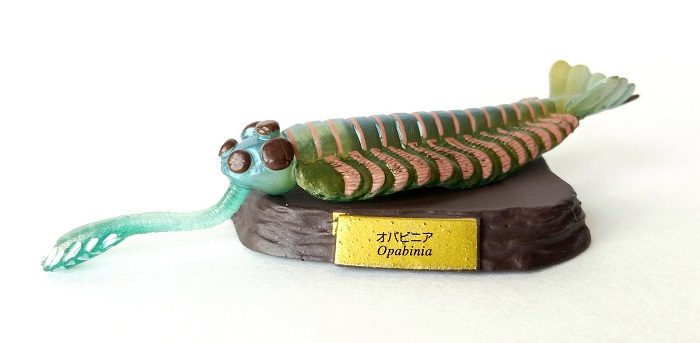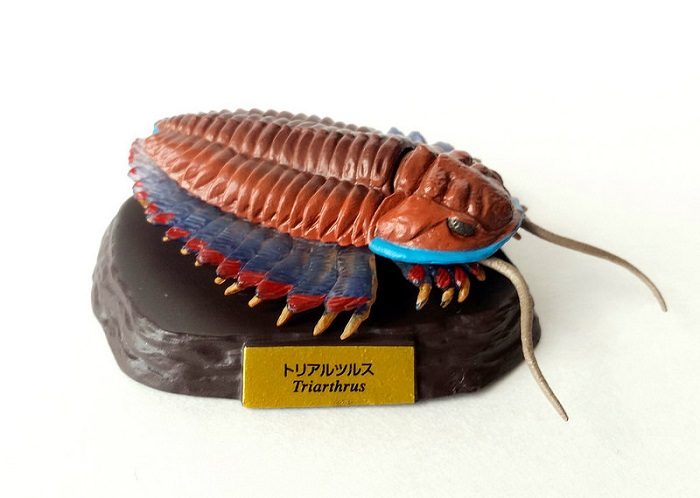Review and photos by Tim Sosa, edited by Suspsy
The interval of Earth’s history which shows fossil evidence of animals is known as the Phanerozoic Eon (literally “visible animals”). The Phanerozoic is divided into three Eras. We live in the Cenozoic, which was preceded by the Mesozoic (during which dinosaurs were the largest terrestrial animals). The Mesozoic began after the largest mass extinction in Earth history, which ended the Paleozoic. Life in the Paleozoic, so remote from us in time, looks quite alien, and it’s perplexing to me that Paleozoic animals don’t get more attention from toy makers.
Which isn’t to say the Paleozoic is completely neglected. Last year Kaiyodo released the “Encyclopedia of the Paleozoic” set as part of the CapsuleQ Museum series. This set consisted of 5 animals from across the Paleozoic. Let’s check them out!

First up is Opabinia, which is well-known from the Burgess Shale. Perhaps because of its excellent remains and bizarre appearance, several versions of this animal have been made before. This sits proudly among the best of them, with the correct number of body segments and the eyes in the right orientation. Opabinia was a stem-arthropod, which means it is related to the ancestors of animals like crabs, insects, and spiders. This figure is roughly life-size: Opabinia was pretty small!

Next up is Triarthrus, a genus of trilobite from the Ordovician period. Like Opabinia, trilobites were arthropods. They were hugely diverse and existed for more than 200 million years, but were among the many victims of the end-Permian extinction. This Triarthrus is approximately life-size and exhibits Kaiyodo’s usual punctiliousness: every joint in the right place. It probably helps that the parts of trilobites that preserve best are the exoskeleton.

Moving on to the Silurian period, we come to Pterygotus, a genus of sea scorpion. Sea scorpions aren’t true scorpions; rather, they appear to be more closely related to horseshoe crabs. This marine arthropod was probably at least partially predatory, and probably the largest animal living at the time. Some of its close relatives were the largest arthropods ever, more than 2 meters long. Pterygotus itself was usually smaller: this figure is around 1:15 scale. Every detail is attended to, from the 12 opisthosomal (that is, behind the head) segments, to the median ocelli (simple light-senstive eyespots) on the head segment.

We march on to the Devonian period, where we find Bothriolepis, one of the commonest fossils in most freshwater deposits of the time. Bothriolepis belonged to one of the earliest lineages of jawed vertebrates, and probably lived a lot like a modern armored catfish. This figure is roughly 1:4 scale.

Toward the end of the Devonian, lobe-finned fishes became common, and some even crawled onto land and gave rise to tetrapods. Eusthenopteron was probably committed to an aquatic existence, but was closely related to animals that would be our ancestors. This large predatory fish had a mouth full of formidable teeth, lovingly rendered in this excellent sculpt. Around 1:25 scale, I think this figure is one of the best prehistoric fish toys ever made.

All of these figures are updated sculpts, usually with nicer paintwork, of animals featured in Kaiyodo’s decade-old Dinotales line. Besides finer sculpting, to my mind these figures are improvements in that they include stands, allowing for more dynamic display options. I also appreciate that they are made of a more pliable plastic, and are therefore less brittle than Dinotales figures. I know some people prefer the older plastic, but I appreciate the fact that I am very unlikely to break these. Like most Japanese capsule figures, these are most often found on auction sites, although you might also be able to get them if you know someone with a connection to Japan.
Disclaimer: links to Ebay and Amazon on the DinoToyBlog are affiliate links, so we make a small commission if you use them. Thanks for supporting us!



Where did u get those and how much are they
They were only sold for a short time, probably less than a year. These days you would have to find them through a re-seller or another collector. You can try an auction site, or you can try the forum, where things like this tend to turn up in the Classified section from time to time. I’d expect to pay $10-$15 per figure on an auction site, and maybe a little less on the forum.
What gorgeous little things!